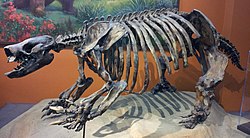Paramylodon
| Paramylodon | |
|---|---|

| |
| Skeleton in San Diego | |
| Scientific classification | |
| Kingdom: | |
| Phylum: | |
| Class: | |
| Superorder: | |
| Order: | |
| Family: | |
| Subfamily: | |
| Tribe: | |
| Genus: | †Paramylodon Brown 1903
|
| Species: | †P. harlani Owen 1840
|
Paramylodon is an extinct genus of ground sloth. It was endemic to North America in the Pliocene, and to the end of the Pleistocene epoch. It lived from around ~4.9 million years ago (mya) to 11,000 years ago.
Paramylodon was about 3 m (9.8 ft) in height and weighted as much as 1089 kg.[1] It is known from deposits in the United States, Mexico and as far south as Guatemala.
There is just one recognized species, P. harlani, (Owen) 1840, which is commonly referred to as Harlan's ground sloth in honor of the American paleontologist who first discovered and described a lower jaw in 1835.
Like the South American Mylodon, Paramylodon had dermal ossicles: small bones embedded in the skin. This made it harder for predators if they attacked from behind. Its skull and teeth suggest it was, like the other members of its group, a browser on leaves and small branches. It ate standing on its hind legs and using its huge hands to pull the vegetation into its mouth. Skeletons found in the La Brea tar pits were more or less complete.
References
[change | change source]- ↑ Extinct Ground Sloth [1] Archived 2015-02-14 at the Wayback Machine
